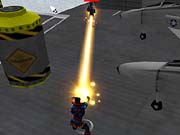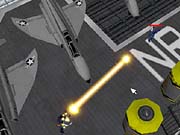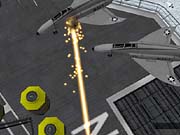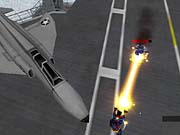Freedom Force Designer Diary #5
Game designer Morgan Jaffit talks about the early decisions he had to make in designing Freedom Force.
Entry #5 - 02/09/01
By Morgan Jaffit
Irrational Games
Hi there--I'm Morgan Jaffit, one of the more recent additions to the Freedom Force team. I've been brought on board to work on some of the design elements and a lot of the nitty-gritty work--scripting, mission design, and so on. For this diary, I'm going to focus a little on some of the choices and decisions one makes when designing a tactical combat game.

From the beginning, every decision you make is going to close doors--which is a good thing overall, as you don't want to have a game that tries to do everything. Every decision brings with it assumptions that are inherited by other decisions. If you end up deciding you want to change your mind at a later date, then you can find yourself in the middle of a very tangled web indeed! So caution and consideration is the name of the game (if you'll excuse the pun).
Looking at early choices, we can see some of the major directions for the game taking shape. For example, you can take up to four characters on a mission. This sets the overall scope of the game--and in turn, that choice influences almost every other section of the game, from camera angles to interface design to the level of detail on the textures. How far away should the camera be? Well, we need to place it far enough so that we can see four characters, their opposition, and their tactical options with relative ease. We don't need to be able to read the time off Minuteman's watch--and neither do we need to be able to see the entire city of New York at any one time.

How flexible do we make the characters? Another choice influenced (and eventually decided) by the game's scope. In your average RTS, each unit has roughly three options available--move, shoot, and sometimes things like guard, patrol, and other more specialized abilities. That's absolutely appropriate for a game that deals with anywhere between a couple of dozen to a couple of hundred units, but it's all a little simplistic when you have only four. On the flip side, it's quite possible to set up any number of interesting tactical combats with just those few options, but we wanted more. So, what happens if we give our characters more? Not only that, but what sorts of options do we consider adding? Here, the superhero genre is a huge help--where's a superhero game (tactical or otherwise) without superpowers? I'll leave the answer to that as an exercise for the reader--Andrew [Chambers from Irrational] has already dealt with some of the different issues that come up when you're looking at a system that lets players design their own powers and use them in a game.
In any case, we're looking at a level of detail that lets you select individuals and make them move and fire with relative ease. In your average RTS, that would pretty much do for a unit's abilities. However, Freedom Force is not an RTS--the focus here is on tactics rather than strategy (moving behind a hill so that the enemy can't shoot you as you advance is tactical; cutting their lines of supply so that they can't build more things to shoot you with is strategic), so we can offer more flexibility in terms of options per unit due to the scope of the game. And we need to--in order to offer more tactical options.
Consider Minuteman--he's the first hero you'll get to play. He focuses primarily on melee attacks-- however, he can also jump to make use of terrain, attack at close range, pick up objects (everything from cars to lamp posts to...well, pretty much everything!) to throw at an enemy (or use it for cover), knock down a building to allow a teammate a clear shot at an enemy, and so on. As Minuteman advances, he'll have even more abilities--everything from reflecting enemy attacks to supercharging his own--to use in combat.

Or instead consider El Diablo, our fire-hurling Mexican with a temper as fiery as his abilities. He's not as strong as Minuteman, so he won't be jumping as high or throwing as far as Minuteman does. On the other hand, El Diablo's specialty is ranged combat. He'll start with a blistering beam of flame that, even though it's short range, gives him plenty of time to get out of the way once he's delivered it. With a bit of time and practice, he'll be able to hurl exploding balls of inferno at his enemies. If he decides that things are getting a little too busy, he can slam the enemies with hellfire--multiple exploding firestorms--from random directions. Of course, you'll want to get the other team members out of the way first! That's just the beginning for El Diablo--as he develops through the game, he can gain new powers or more fully master the ones he has. In fact, every character can, including the ones you develop yourself!
However, with this level of complexity for each of the pregenerated characters (of which there are going to be quite a few) and the characters designed by the player, there are a massive number of challenges from a design point of view. It's one thing to design, for example, an alien attack hamster to deal with Minuteman--all that should be required is some sort of stasis beam to freeze him in place while the other hamsters gnaw on his legs. But what if you're using a superfast character who can get out of the way of the beam? Or a teleporter? Or a hero with the ability to reflect beam weapons? Or someone who can control the minds of hamsters from a distance and cause them to turn upon one another? (Have you ever read a hamster's mind? Scary stuff.)

Ultimately, all these factors have to be taken into consideration every step along the way. You can't add a new power without considering how it will affect every enemy (and hero) you've designed so far. You can't add a new enemy without taking into consideration how it will interact with the heroes you have in place and the heroes you may create. That's just one example of the sort of balances you need to take into account with every addition--as I said in the beginning, every decision you make closes potential doors. Ultimately, that's what defining a game is all about. Otherwise, you end up with a real-time and turn-based hybrid action game with first-person shooter, strategy, and role-playing elements, all in one--which, while it may look good on the back of the box, will probably have the playability of a house brick if you're lucky (someone will now develop a game just like this and sell millions just to spite me).
This month, we're focusing on hammering all those numbers into a semblance of shape. The game engine exists (which is not to say it's complete--but it does give a good impression of how the final game will feel), and everything is starting to fall into place. Ultimately, it's the interactions between different powers and abilities (those of your team and your enemies) that are going to go a long way toward actually making the game fun and interesting. The methods you have for dealing with a mission with Mentor and Minuteman will be entirely different from taking El Diablo and a character of your own devising. These methods change again depending on whether you're facing off against thugs or against a powerful supercriminal--or at least we thinkthey will if we do our job right.
Ultimately, that's a large part of the design process--ensuring that there's plenty of variety and, more importantly, fun.
Got a news tip or want to contact us directly? Email news@gamespot.com
Join the conversation